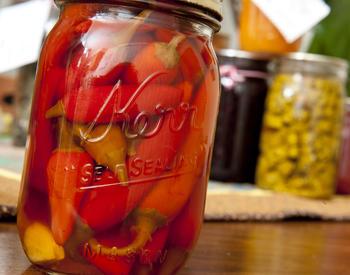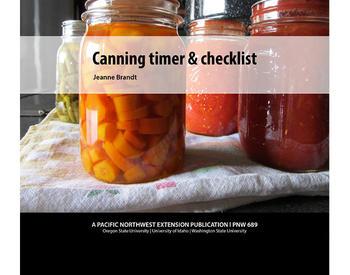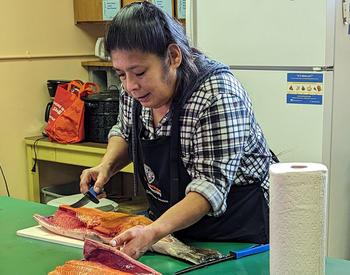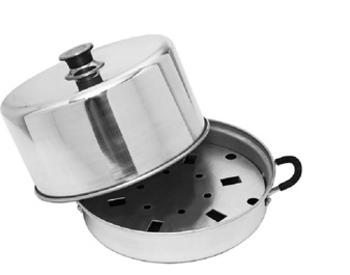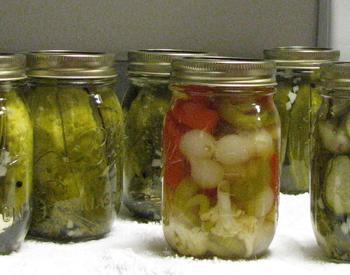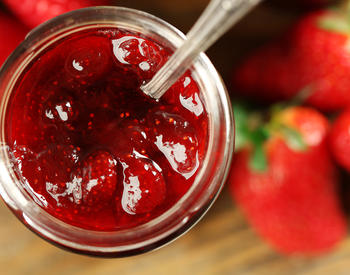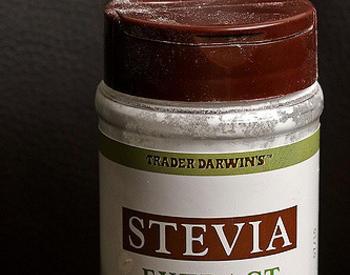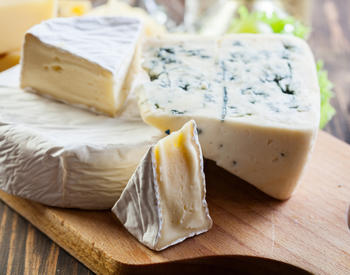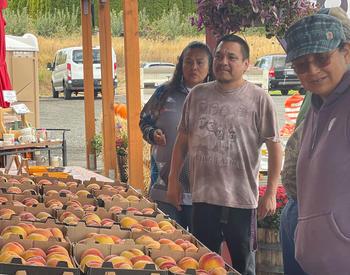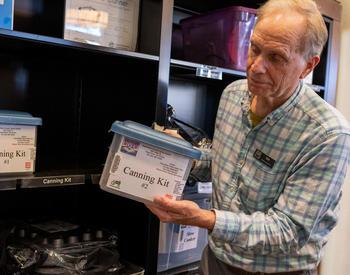Download this publication as a PDF
Many varieties of apples are grown in Oregon. Good varieties for sauce and pies include Gravenstein, Golden Delicious, Rome Beauty, Yellow Newton, Ruby, Lodi, Mutsu, Granny Smith, Spartan, Honey Crisp and Melrose.
Whatever variety you choose, select juicy, crisp apples that are neither too green nor too ripe.
It takes about 2½ –3 pounds of apples to fill a quart jar. A bushel of apples weighs about 48 pounds and yields about 16–20 quarts of sliced fruit or 15–18 quarts of sauce.
Apples may be canned, frozen, dried, and made into jelly and butter.
Canning
Canning apple slices
Apples must be processed in a boiling water canner. Ask your county Extension office for time adjustments if you live above 1,000 feet.
Wash, pare, core and slice apples. Remove any bruises or decay. To keep fruit from darkening during preparation, drop into water containing 1 teaspoon ascorbic acid powder per gallon of water or crush and dissolve six 500-milligram vitamin C tablets per gallon of water. Drain.
The hot pack method is recommended. Boil apple slices in sugar syrup, juice or water for 5 minutes, stirring occasionally to prevent scorching. Fill hot jars with hot apple slices and cover with boiling cooking liquid, leaving ½-inch headspace.
Remove air bubbles by running a plastic spatula or blunt knife between the fruit and the jar. Wipe rims and adjust lids.
Process in a boiling water canner: pints and quarts for 20 minutes. After processing, take canner off heat. Remove lid and wait 5 minutes before removing jars.
Canning apple pie filling
Instructions are available in SP 50-616 Fruit Pie Fillings.
Canning applesauce
Wash and core apples. Remove peel.* Cut large fruit into slices. Simmer until soft, adding a small amount of water to prevent sticking. Apple slices can also be cooked in the microwave. Two quarts sliced apples will cook in 12–15 minutes in a covered 2–3 quart casserole or bowl on high power.
*Peeling is especially recommended when making applesauce from windfalls. Applesauce made from unpeeled apples can result in a higher incidence of spoilage during storage.
When apples are tender, put them through a food mill or strainer. Omit this step for chunky-style sauce. Add sugar to taste.
Reheat applesauce to boiling and pack hot into jars, leaving ½-inch headspace. Adjust lids and process in a boiling water canner: 15 minutes for pints; 20 minutes for quarts. After processing, take canner off heat. Remove lid and wait 5 minutes before removing jars.
Applesauce may also be frozen. Cool sauce before freezing.
Spiced apple rings
Yield: approximately 8–9 pints
- 12 lbs firm, tart apples (maximum diameter, 2½ inches)
- 12 cups sugar
- 6 cups water
- 1¼ cups white vinegar (5%)
- 3 Tbsp whole cloves
- ¾ cup red hot cinnamon candies or 8 cinnamon sticks and 1 tsp red food coloring
Procedure:
- Wash apples. Cut crosswise into ½ inch slices.
- Remove core area with an apple corer or melon baller.
- To prevent darkening during preparation, put cut fruit into water containing 1 teaspoon ascorbic acid powder per gallon of water, or crush and dissolve six 500 milligram vitamin C tablets per gallon of water.
- To make syrup, combine remaining ingredients except apples in a 6-quart saucepan.
- Stir, heat to boiling and simmer 3 minutes.
- Drain apples, add to hot syrup and cook 5 minutes.
- Fill half-pint or pint jars (preferably wide-mouth) with apple rings and hot syrup, leaving ½ inch head space.
- Adjust lids and process 10 minutes in a boiling water canner. At 1,001-6,000 ft altitude, process for 15 minutes; above 6,000 ft, process 20 minutes. After processing, take canner off heat. Remove lid and wait 5 minutes before removing jars.
Spiced crab apples
Yield: approximately 9 pints
- 5 lbs crab apples
- 4½ cups cider vinegar (5%)
- 3¾ cups water
- 7½ cups sugar
- 4 tsp whole cloves
- 4 sticks cinnamon
- 6 ½-inch cubes of fresh ginger root
Procedure:
- Remove blossom petals and wash apples, leaving stems attached. Puncture the skin of each apple four times with an ice pick or tooth pick.
- Mix vinegar, water and sugar together in a saucepan and bring to a boil. Add spices tied in a cheesecloth bag. Using a blancher basket or sieve, immerse one-third of the apples at a time in the boiling syrup and cook for 2 minutes.
- Place cooked apples and spice bag in a clean 1 or 2-gallon crock, bowl or jar and add hot syrup.
- Cover and let stand overnight. Remove spice bag, drain syrup into a large saucepan, and reheat to boiling.
- Fill pint jars with apples and hot syrup, leaving ½ inch headspace. Adjust lids and process 20 minutes in a boiling water canner; at 1,001-3,000 feet altitude, process 25 minutes; 3,001-6,000 feet altitude, process 30 minutes, above 6,000 feet, process 35 minutes.
- After processing, take canner off heat. Remove lid and wait 5 minutes before removing jars.
Preserves
Apple butter
- 2 quarts apple pulp or unsweetened applesauce
- 4 cups sugar
- 2 teaspoons ground cinnamon
- ½ teaspoon ground cloves
Procedure:
- Prepare pulp by washing apples and removing peels and cores. Slice and add sugar, spices and a little water, if needed. Cook in small batches until thick.
- The butter may be simmered on top of the stove in a heavy kettle, cooked in the oven (at 275°F) in a shallow baking pan or cooked in the microwave oven. The butter is ready when it rounds slightly on a spoon and has a glossiness or sheen.
- Cooked butters should be packed immediately into hot sterile jars, leaving ¼-inch headspace.
- Adjust lids and process in boiling water canner: 5 minutes for pints and half pints; 10 minutes for quarts. After processing, take canner off heat. Remove lid. Wait 5 minutes before removing jars.
- Butters can also be frozen or stored for short periods of time in the refrigerator.
Apple jelly
- Wash and remove the stem and blossom ends. Slice but do not core. Cook the apples until tender and put in a jelly bag to let the juice drain.
- Apple jelly can be made with or without added pectin. If pectin is not used, one-fourth of the apples should be underripe.
Freezing
- Wash apples and remove peel and core. Slice to desired thickness.
- To keep fruit from darkening during preparation, drop into water containing 1 teaspoon ascorbic acid powder per gallon of water or crush and dissolve six 500-milligram vitamin C tablets per gallon of water. Drain.
Sugar pack
- Layer a couple inches of apples in a bowl.
- Sprinkle with sugar. Repeat until all apples are sugared. Cover and let set for several hours, or until sugar is dissolved and apples have made their own juice.
- Pack apples and juice in freezer containers.
Syrup pack
- Prepare a light syrup (1½ cups sugar to 4 cups water, heat to dissolve sugar, cool).
- Pack apples into freezer containers and cover with cooled syrup.
Drying
- Wash apples and remove peel, if desired, and core.
- Cut into slices or rings ¼- to ⅓-inch thick.
- To keep fruit from darkening during preparation, drop into water containing 1 teaspoon ascorbic acid powder per gallon of water or crush and dissolve six 500-milligram vitamin C tablets per gallon of water.
- Drain well and spread in thin layer on drying trays. Dry until leathery and pliable in the sun or in an oven or dehydrator at 140°F.
- Store in cool, dry, dark location.
For additional information on preserving apples, contact your local county Extension office.
Related articles
